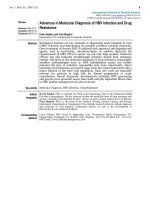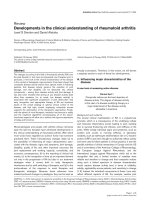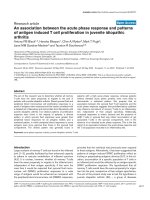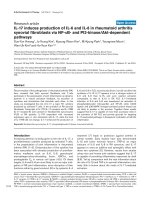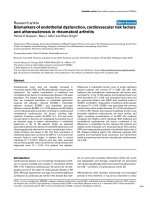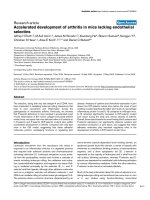Báo cáo y học: "Remission in psoriatic arthritis: is it possible and how can it be predicted" pdf
Bạn đang xem bản rút gọn của tài liệu. Xem và tải ngay bản đầy đủ của tài liệu tại đây (507.24 KB, 6 trang )
Saber et al. Arthritis Research & Therapy 2010, 12:R94
/>Open Access
RESEARCH ARTICLE
BioMed Central
© 2010 Saber et al.; licensee BioMed Central Ltd. This is an open access article distributed under the terms of the Creative Commons
Attribution License ( which permits unrestricted use, distribution, and reproduction in
any medium, provided the original work is properly cited.
Research article
Remission in psoriatic arthritis: is it possible and
how can it be predicted?
Tajvur P Saber
1,2
, CT Ng
1,2
, Guillaume Renard
1,2
, Bernadette M Lynch
1,2
, Eliza Pontifex
1,2
, Ceara AE Walsh
1,2
,
Alexia Grier
1,2
, Marian Molloy
1,2
, Barry Bresnihan
1,2
, Oliver FitzGerald
1,2
, Ursula Fearon
1,2
and Douglas J Veale*
1,2
Abstract
Introduction: Since remission is now possible in psoriatic arthritis (PsA) we wished to examine remission rates in PsA
patients following anti tumour necrosis factor alpha (TNFα) therapy and to examine possible predictors of response.
Methods: Analysis of a prospective patient cohort attending a biologic clinic, between November 2004 and March
2008, was performed prior to commencing therapy and at regular intervals. Baseline clinical characteristics including
demographics, previous disease-modifying antirheumatic drug (DMARD) response, tender and swollen joint counts,
early morning stiffness, pain visual analogue score, patient global assessment, C reactive protein (CRP) and health
assessment questionnaire (HAQ) were collected.
Results: A total of 473 patients (152 PsA; 321 rheumatoid arthritis (RA)) were analyzed. At 12 months remission, defined
according to the disease activity score using 28 joint count and CRP (DAS28-CRP), was achieved in 58% of PsA patients
compared to 44% of RA patients, significant improvement in outcome measures were noted in both groups (P < 0.05).
Analysis of a subgroup of PsA and RA patients matched for DAS28-CRP at baseline also showed higher numbers of PsA
patients achieving remission. Linear regression analysis identified the HAQ at baseline as the best predictor of
remission in PsA patients (P < 0.001).
Conclusions: DAS28 remission is possible in PsA patients at one year following anti-TNF therapy, at higher rates than in
RA patients and is predicted by baseline HAQ.
Introduction
Psoriatic arthritis (PsA) is a chronic inflammatory arthri-
tis, usually seronegative for rheumatoid factor associated
with psoriasis [1,2]. The clinical phenotype varies widely,
which has led to difficulties with classification, diagnosis
and therefore predicting prognosis. Initially, PsA was
considered a benign disease, one study suggesting only
11% of patients developed erosions over seven years [3].
However, in the same journal it was highlighted that a
number of reports suggested a high occurrence of ero-
sions in between 46 to 62% of patients [4]. The incidence
of PsA varies from 5.4 to 42% depending on the report. In
a Finnish population based study 46% developed erosions
[5] and in another study 62% of patients worsened and
the pattern of disease changed over time [6]. Several
recent studies, however, suggest PsA is progressive, often
disabling and associated with an increased mortality [7].
In a study of PsA, in an early arthritis clinic, it accounted
for 13% of new patients and progressive, erosive damage
occurred in almost 50% patients in the first two years [8].
In the absence of evidence from randomized clinical
trials, Methotrexate (MTX) is generally accepted to be
useful for the control of peripheral arthritis, but has little
efficacy in spinal disease [9]. In a study of early PsA, how-
ever, erosive damage appeared to develop even when
MTX therapy was commenced early [8]. This raises the
question 'Should anti-TNF agents be introduced early?'
Remission implies the reversibility of functional impair-
ment, minimal or no progression to joint destruction, and
at least a theoretic potential to heal a damaged joint [10].
Recent studies suggest remission may now be attainable
in rheumatoid arthritis (RA) with the advent of anti-TNF
therapy [11], however RA remission has been defined by
different criteria (i) DAS28 value of ≤2.6 [12] (ii) imaging
- no progression on X-ray/Ultrasound/MRI; or (iii)
* Correspondence:
1
Department of Rheumatology, Dublin Academic Medical Centre, St Vincent's
University Hospital, Elm Park, Dublin 4, Ireland
Full list of author information is available at the end of the article
Saber et al. Arthritis Research & Therapy 2010, 12:R94
/>Page 2 of 6
American College of Rhuematology (ACR) criteria [13].
Drug-induced remission may be defined as minimal or no
clinically detectable disease activity in the presence of
continuing drug treatment, which is not stopped or inter-
rupted, but is required to retain the remission state [14].
Drug-free remission persists in the absence of medica-
tion. In a recent editorial, de Vlam and Lories highlighted
that remission may be a possible goal in PsA [15].
In the current prospective study, we specifically exam-
ine clinical and laboratory measures of disease activity to
estimate remission rates in PsA patients and examine
associated predictive factors.
Materials and methods
We established a biologic outpatient clinic and prospec-
tive database to provide close monitoring and follow-up
of patients on biologic therapies. Patients commencing
Infliximab, Adalimumab and Etanercept were assessed at
baseline, 3, 6 and 12 months with clinical examination,
swollen joint count (SJC) and tender joint count (TJC),
visual analogue scores (VAS) for pain and for patient
global, Health Assessment Questionnaire (HAQ). Eryth-
rocyte sedimentation rate (ESR) and C-reactive protein
(CRP) were measured and the 28-joint count Disease
Activity Score, DAS28 calculated. RA patients fulfilled
diagnostic criteria for according to American College of
Rheumatology criteria [13], and PsA patients satisfied
validated CASPAR criteria [16]. All patients had clinically
active disease, with DAS28 > 3.2 points despite conven-
tional DMARD therapy, and were offered treatment with
biologic agents. Patients who had previously received bio-
logic therapy were excluded from this analysis.
Patients received education prior to commencing bio-
logic therapy and thereafter gave fully informed verbal
consent. Details of patient age, gender, diagnosis, disease
duration, RF and CCP antibody status were collected.
DAS28 which has been validated for use in PsA [17] and
RA patients and modified (HAQ) [18] was calculated.
DAS28 response was analyzed by change from baseline,
and by the European League Against Rheumatism
(EULAR) criteria response categories [19]. All treatment
was fully in compliance withthe Helsinki Declaration and
the analysis was approved by the St. Vincent's University
Hospital ethics committee.
Statistics
Statistical analysis was performed using SPSS 16 for Win-
dows. Clinical data are expressed as median values and
range unless otherwise stated. Comparisons of improve-
ment within a disease group at different time points were
performed using Wilcoxon Rank Sign test. Chi square
test for categorical data and Mann-Whitney U test for
continuous data were used to evaluate the statistical sig-
nificance of the difference between the two independent
groups, PsA and RA.
Results
Demographic characteristics
Data were collected and analyzed from a total of 473
patients (152 PsA; 321 RA) over a one-year follow-up
period. Baseline describes time of first dose of anti TNF
therapy. Baseline characteristics including demographics,
clinical and laboratory data are shown in Table 1. These
values are expressed as medians (range). As expected
from previous cohort studies, the PsA patients tended to
be younger, male and had lower joint counts and disease
activity scores in comparison to RA patients. PsA patients
received Infiximab-13%, Adalimumab-37% and Etaner-
cept-50%, whereas in RA these drugs were used in 6.8%,
56% and 37.2% of patients respectively. The PsA cohort
had oligoarticular disease (27.4%) and polyarticular dis-
Table 1: Baseline variables shown in median(range) unless otherwise stated
PsA (n = 152) RA (n = 321) P value
Age 45(15 to 77) 56(17 to 85) <0.001
Male 47.7% 29.1% <0.001
Female 52.3% 70.9%
Disease Duration 8(0.1 to 45) 10(0.1 to 42) = 0.01
Previous MTX Use 94.6% 92.6%
Rheumatoid Factor Positive 0.0% 77.6%
Anti CCP Positive 0% 72%
VAS (mm) 60(10 to 100) 60(10 to 100) ns
Concomitant DMARD 36% 68.4%
Steroid use 14% 41.5% <0.001
DMARD: disease modifying agents of rheumatic diseases; MTX: methotrexate;
PsA: psoriatic arthritis; RA: rheumatoid arthritis; VAS: visual analogue scale of patient global health
Saber et al. Arthritis Research & Therapy 2010, 12:R94
/>Page 3 of 6
ease (72.6%). Baseline joint counts, CRP and HAQ for
PsA patients are shown in Figure 1.
Clinical outcome measures in PsA patients
In PsA patients the TJC was 7.9 ± 0.532 (mean ± SEM) at
baseline, reduced to 3 ± 0.477 at 3 months, 1.97 ± 0.38 at
6 months and 1.79 ± 0.45 at 12 months (P < 0.01) (Figure
1A). The baseline SJC was 7.13 ± 0.51, reduced to 2.16 ±
0.3 at 3 months, 1 ± 0.22 at 6 months and 1 ± 0.25 at 12
months (P < 0.01) (Figure 1B). The patient global VAS
was 5.5 ± 0.19 at baseline and reduced to 2.9 ± 0.22 at 3
months had a value of 2.3 ± 0.23 at 6 months and then
remained at this level so that the mean value at 12
months was 2.2 ± 0.25. The baseline CRP in the PsA
patients was 18 ± 1.83 which fell to 6.8 ± 1.14 at 3 months
(P < 0.01) and remained at this level at 6 and 12 months
(Figure 1C). The HAQ at baseline was 0.91 ± 0.05 and sig-
nificantly improved to 0.625 ± 0.08 at 3 months then to
0.470 ± 0.06 at 6 months and maintained out to 12
months (all P values < 0.01) (Figure 1D).
Remission rates in PsA
In the PsA patients the DAS28 remission rate, computed
with four variables using the CRP, at 12 months was 58%.
This represented a significant change from a baseline of
4.75 ± 0.09 to 3.1 ± 0.12 at 3 and 2.6 ± 0.11 at 6 months,
and a further reduction to 2.5 ± 0.13 at 12 months (all P
values < 0.01) (Figure 2A). A significant improvement in
DAS28 was also demonstrated in RA patients from base-
line to 12 months, although the overall remission rate of
44% was significantly lower than in the PsA patients. (Fig-
ure 2).
As there was a significant difference in DAS28 scores
between the PsA and RA at baseline, we analysed a sub-
group of PsA (n = 41) and RA (n = 41) patients which
were matched for baseline DAS28 scores (Figure 2B).
Analysis of these matched PsA and RA patient subgroups
still demonstrated a significantly higher number of PsA
patients attaining remission 63.5% at 12 months com-
pared to the RA group 41.4% (Figure 2B). In addition, the
rate of achieving remission in the PsA patients was signif-
icantly higher compared to RA patients at 3, and 6 and 12
months (all P < 0.01) (Figure 3).
Predictors of remission
In an individual analysis of baseline variables (Table 2) a
number of features appeared to predict the clinical out-
come of remission as defined by DAS28 < 2.6. Specifi-
cally, in PsA patients male gender, HAQ, Patient global
VAS and early morning stiffness were independently
associated with increased remission. Linear regression
analysis of baseline characteristics, however suggest that
the HAQ at baseline is the sole predictor of DAS28 at one
year (P < 0.001).
Discussion
In this study, we show a significant response to anti-TNF
therapy in routine clinical practise with DAS28 remission
in 58% PsA patients compared to 44% of RA patients.
There were significant differences in single variables and
the DAS28 scores between PsA and RA patients at base-
line. This may reflect differences in pattern of joint
involvement and/or lower CRP levels frequently noted in
PsA compared with RA patients [17]. To reduce the pos-
sible bias due to differences at baseline between PsA and
RA, we analysed a subgroup matched for baseline DAS28,
this still showed a significantly greater response in PsA
patients compared to RA. While response rates in PsA
have been looked at before, these studies looked into
EULAR response rates [20] and did not comment on
DAS28 response, or remission, as we do here.
Individual variables including tender and swollen joint
counts, CRP, patient global VAS and the HAQ showed
significant improvement in both patient groups, most
parameters showed the greatest response within the first
3 months, however significant improvements were seen
between 3 and 12 months, residual tender and swollen
joints were more common in RA patients. The mean CRP
fell in both PsA and RA patients, it fell more sharply in
the PsA group overall, however, in the matched PsA and
RA subgroup analysis CRP changes were comparable.
The patient reported outcomes such as patient global
VAS, pain VAS and HAQ also showed significant
Figure 1 Individual clinical outcome measures in Psoriatic arthri-
tis over time. The top left graph depicts the rapid response of Tender
Joint Count (TJC) to commencement of treatment with a biologic
agent. The top right shows similar response of Swollen Joint Count
(SJC). The bottom left graph shows CRP mg/L decline with biologic
therapy. The bottom right graph shows HAQ and its dramatic improve-
ment. Time is shown as O for baseline and then 3, 6 and 12 months.
8
8
(
a
)
(
b
)
4
6
SJC28
TJC28
4
6
8
**
**
()
()
0
2
0
3
6
12
0
2
1
2
3
4
***
**
0
3
6
12
Months
125
1
2
3
4
Months
(c)
(
d
)
0.6
0.8
HAQ
10
15
20
CRP
**
**
**
*
()
0.2
0.4
03612
0
5
10
0
3612
h
**
Months
Mont
h
s
Saber et al. Arthritis Research & Therapy 2010, 12:R94
/>Page 4 of 6
improvement in both patient groups. PsA patients had
less tender and swollen joints and stiffness at 12 months,
but also a significantly lower DAS 28 and HAQ.
Fifty-eight percent of PsA patients were in DAS28
remission at 12 months compared to 44% of RA patients.
When the two groups were analysed as regards EULAR
good response, that is, a DAS28 of <3.2 at endpoint and
and improvement of more than or equal to 1.2, then 73%
of PsA, but only 51% of RA patients, met this criteria. It
was interesting to note that male PsA patients attained
significantly lower DAS28 scores than females 1.88 vs
2.65 at one year (P < 0.05). Since the initial DAS28 in PsA
was lower than RA patients when biologic treatment
started we compared remission rates in PsA vs RA, by
analyzing a subset of patients matched for disease activity
at baseline (n = 41, in each group). Remission rates
defined by DAS28 were significantly greater in PsA
patients (P = 0.01), 63.5% PsA patients vs 41.4% RA
patients at 12 months even in this particular group.
This is the first study to examine remission rates in a
cohort of PsA patients from routine clinical practise stud-
Figure 2 Comparison of DAS28-CRP response in PsA versus RA patients over time. 2a DAS28-CRP in PsA (dotted line) is compared to RA (solid
black line). Remission represented by the line at DAS28 value of 2.6. There is a highly significant response of PsA compared to RA at all time points. 2b
shows a subgroup of patients matched for disease activity at baseline (n = 41 in each group) and similar dramatic response.
6 6
5
**
5
(a) (b)
4
D
AS28
**
**
**
4
D
AS28
** **
**
2
3
D
2
3
D
1
03612
1
1234
Months
Months
Figure 3 Percentage of patients in DAS28-CRP remission over
time. PsA represented by the dotted line shows a dramatic immediate
response to Biologic therapy compared to RA, represented by solid
black line. A total of 58% PsA patients are in remission at 12 months
compared to 44% of RA patients.
60
50
60
30
40
S
28remission
20
%DA
S
0
10
03 6 12
Months
0
3
6
12
Table 2: DAS28 at one year prediction by correlation with
individual factors at baseline
P value
HAQ <0.001
Gender 0.004
Pt global VAS 0.035
Stiffness <0.001
Pain 0.032
Fatigue 0.06
HAQ: health assessment questionnaire; Pt global VAS: patient
global visual analogue scale of disease activity.
Saber et al. Arthritis Research & Therapy 2010, 12:R94
/>Page 5 of 6
ied prospectively in a dedicated biologic clinic. The find-
ing of DAS28 remission in almost two-thirds of patients
is significantly higher than the observed level in RA
patients, even when matched for baseline disease activity.
Remission has become an attainable goal in the treatment
of RA, the recent Combination of Methotrexate and etan-
ercept in Active Early Rheumatoid (COMET) study sug-
gesting high remission rates in RA patients with high
levels of disease activity commenced on treatment early
[21]. The aim of remission in the treatment of RA has
been adopted as desirable and feasible by EULAR in the
most recent recommendations [22]. In a recent editorial,
the potential of remission in PsA was considered to be a
realistic goal [15]. There are several possible criteria
which may be used in the definition of remission, includ-
ing single clinical variables, response criteria, pooled
indices such as the DAS and ACR and then imaging tech-
nology criteria. In an important study of the performance
of response criteria for assessment of peripheral arthritis
in PsA, Fransen et al, compared a detailed analysis of
individual items and pooled indices in dicriminating
change in two clinical trial data sets [19]. The authors
concluded that response criteria and pooled indices, spe-
cifically the EULAR response criteria, performed better
than the ACR or the PsARC in discriminating active from
placebo drugs. In addition, they found that the DAS and
DAS28 performed better than single core-set measures in
PsA. Furthermore, two studies have reported that the
DAS28 is a valid instrument for measuring disease activ-
ity with respect to response to biologic therapies [19,23].
In measuring remission in this prospective cohort study
we have applied the DAS28, as a validated measure of dis-
ease activity in PsA patients treated with biologics, and in
the knowledge that such a pooled index developed for RA
has been shown to be useful for assessment of the periph-
eral arthritis of PsA. The results of this study suggest
therefore that, using a single measure of disease activity
with an agreed level defined as remission, biologic thera-
pies result in high remission rates in PsA patients, greater
than a comparator group of RA patients even when
matched for baseline disease activity.
In this study we found a number of individual baseline
parameters were associated with remission examining
independent correlations. In particular, in PsA patients,
male gender and the patient-derived indices including
HAQ, patient global VAS and early morning stiffness
appeared to be associated with remission. Linear regres-
sion analysis however failed to confirm all these variables
as predictors of remission and suggested the association
was strongest between baseline HAQ and remission. A
previous report of PsA patients treated with anti-TNF
agents had identified improvement in the DAS28 score as
the best predictor of improvement in quality of life (QoL)
measured using the SF36 [24]. Interestingly, the authors
of this paper also found significantly higher QoL
responses in their PsA cohort compared to the RA cohort
studied, a result which confirmed an earlier report from
the Norwegian registry [25]. In a recent international
multicenter study of RA patients [26], measures of HAQ
also behaved differently in men and women. We therefore
reanalysed the data in our RA cohort and found there are
differences in men and women in relation to HAQ
response; however, the size of the response in male PsA
and RA patients is similar. The association of male gender
with remission was unexpected and raises an intriguing
question: Why do male PsA patients show a better
response to therapy? One possible explanation is related
to testosterone levels, which have previsouly been
reported to be higher in HLAB27 positive subjects [27],
and may have a protective effect in seronegative spondy-
loarthopathies [28]. Indeed, it is intriguing to hypothesize
that testosterone levels may augment the response of PsA
patients to biologic therapies.
Conclusions
This is the first prospective study of biologic therapy in a
routine clinical inflammatory arthritis cohort to demon-
strate a remission rate of over 58% in patients with PsA.
Remission, defined by DAS28, has been validated in PsA
biologic therapy trials, and shown to be more responsive
than single outcome measures. Furthermore, we have
shown that DAS remission is significantly higher in this
PsA cohort compared to an RA cohort, even when
matched for baseline disease activity. The remission
response in the PsA patients appears to be most strongly
associated with the patient-derived outcome measure of
function - HAQ. These data suggest that remission is
both a realistic and achievable goal in the majority of PsA
patients.
Abbreviations
ACR: American College of Rhuematology; Anti TNFα: anti tumour necrosis fac-
tor alpha; CRP: C reactive protein; DMARD: disease modifying agents of rheu-
matic diseases; ESR: erythrocyte sedimentation rate; EULAR: European League
Against Rheumatism; HAQ: health assessment questionaire; MRI: magnetic res-
onance imaging; MTX: methotrexate; PsA: psoriatic arthritis; QoL: quality of life;
RA: rheumatoid arthritis; SJC: swollen joint count; TJC: tender joint count; VAS:
visual analogue scale.
Competing interests
TS has received a Newman scholarship through UCD supported by Centocor
Ltd and so on. OF has grant/research support from Abbott and BMS; he also
acts as a consultant for Abbott and UCB and is on the Speakers Bureau for
Abbott. DJV has grant/research support, acts as a consultant for and is on the
Speakers Bureau for from Abbott, GSK, Centocor, Wyeth, Pfizer and Schering
Plough. The other authors declare that they have no competing interests.
Authors' contributions
TPS was responsible for author conception, design, acquisition of data, analysis
and interpretation of data, and also for drafting of the manuscript. VCTN was
responsible for conception, acquisition of data, analysis and interpretation of
data. GR was responsible for analysis and interpretation of data, and also for
drafting of the manuscript. BML, EP, CAEW, AG and MM were responsible for
acquisition of data. BB was responsible for conception and interpretation of
Saber et al. Arthritis Research & Therapy 2010, 12:R94
/>Page 6 of 6
data, and, along with OF, was responsible for conception and acquisition of
data. UF was responsible for the design, analysis and interpretation of data, and
also for drafting of the manuscript. DJV was responsible for conception, design,
acquisition of data, analysis and interpretation of data and drafting of the man-
uscript.
Acknowledgements
This study was completely funded by the St Vincent's Hospital. The authors'
own funding sources are listed in Competing interests.
Author Details
1
Department of Rheumatology, Dublin Academic Medical Centre, St Vincent's
University Hospital, Elm Park, Dublin 4, Ireland and
2
The Conway Institute of
Biomolecular and Biomedical Research, University College Dublin, Belfield,
Dublin 4, Ireland
References
1. Reece RJ, Canete JD, Parsons WJ, Emery P, Veale DJ: Distinct vascular
patterns of early synovitis in psoriatic, reactive, and rheumatoid
arthritis. Arthritis Rheum 1999, 42:1481-1484.
2. Taylor W, Gladman D, Helliwell P, Marchesoni A, Mease P, Mielants H:
Classification criteria for psoriatic arthritis: development of new criteria
from a large international study. Arthritis Rheum 2006, 54:2665-2673.
3. Shbeeb M, Uramoto KM, Gibson LE, O'Fallon WM, Gabriel SE: The
epidemiology of psoriatic arthritis in Olmsted County, Minnesota, USA,
1982-1991. J Rheumatol 2000, 27:1247-1250.
4. Veale DJ: The epidemiology of psoriatic arthritis: fact or fiction? J
Rheumatol 2000, 27:1105-1106.
5. Kaipiainen-Seppanen O: Incidence of psoriatic arthritis in Finland. Br J
Rheumatol 1996, 35:1289-1291.
6. Jones SM, Armas JB, Cohen MG, Lovell CR, Evison G, McHugh NJ: Psoriatic
arthritis: outcome of disease subsets and relationship of joint disease
to nail and skin disease. Br J Rheumatol 1994, 33:834-839.
7. Gladman DD: Mortality in psoriatic arthritis. Clin Exp Rheumatol 2008,
26:S62-65.
8. Kane D, Pathare S: Early psoriatic arthritis. Rheum Dis Clin North Am 2005,
31:641-657.
9. van der Horst-Bruinsma IE, Clegg DO, Dijkmans BA: Treatment of
ankylosing spondylitis with disease modifying antirheumatic drugs.
Clin Exp Rheumatol 2002, 20:S67-70.
10. Emery P, Gabay C, Kraan M, Gomez-Reino J: Evidence-based review of
biologic markers as indicators of disease progression and remission in
rheumatoid arthritis. Rheumatol Int 2007, 27:793-806.
11. Breedveld FC, Emery P, Keystone E, Patel K, Furst DE, Kalden JR, St Clair EW,
Weisman M, Smolen J, Lipsky PE, Maini RN: Infliximab in active early
rheumatoid arthritis. Ann Rheum Dis 2004, 63:149-155.
12. Saleem B, Nizam S, Emery P: Can remission be maintained with or
without further drug therapy in rheumatoid arthritis? Clin Exp
Rheumatol 2006, 24:S-33-S-36.
13. Arnett FC, Edworthy SM, Bloch DA, McShane DJ, Fries JF, Cooper NS,
Healey LA, Kaplan SR, Liang MH, Luthra HS, et al.: The American
Rheumatism Association 1987 revised criteria for the classification of
rheumatoid arthritis. Arthritis Rheum 1988, 31:315-324.
14. Goekoop-Ruiterman YP, de Vries-Bouwstra JK, Allaart CF, van Zeben D,
Kerstens PJ, Hazes JM, Zwinderman AH, Ronday HK, Han KH, Westedt ML,
Gerards AH, van Groenendael JH, Lems WF, van Krugten MV, Breedveld
FC, Dijkmans BA: Clinical and radiographic outcomes of four different
treatment strategies in patients with early rheumatoid arthritis (the
BeSt study): a randomized, controlled trial. Arthritis Rheum 2005,
52:3381-3390.
15. de Vlam K, Lories RJ: Remission in psoriatic arthritis. Curr Rheumatol Rep
2008, 10:297-302.
16. Symmons DP, Lunt M, Watkins G, Helliwell P, Jones S, McHugh N, Veale D:
Developing classification criteria for peripheral joint psoriatic arthritis.
Step I. Establishing whether the rheumatologist's opinion on the
diagnosis can be used as the "gold standard". J Rheumatol 2006,
33:552-557.
17. Vander Cruyssen B, De Keyser F, Kruithof E, Mielants H, Van den Bosch F:
Comparison of different outcome measures for psoriatic arthritis in
patients treated with infliximab or placebo. Ann Rheum Dis 2007,
66:138-140.
18. Ziebland S, Fitzpatrick R, Jenkinson C, Mowat A: Comparison of two
approaches to measuring change in health status in rheumatoid
arthritis: the Health Assessment Questionnaire (HAQ) and modified
HAQ. Ann Rheum Dis 1992, 51:1202-1205.
19. Fransen J, van Riel PL: The Disease Activity Score and the EULAR
response criteria. Clin Exp Rheumatol 2005, 23:S93-99.
20. Coates LC, Cawkwell LS, Ng NW, Bennett AN, Bryer DJ, Fraser AD, Emery P,
Marzo-Ortega H: Sustained response to long-term biologics and
switching in psoriatic arthritis: results from real life experience. Ann
Rheum Dis 2008, 67:717-719.
21. Emery P, Breedveld FC, Hall S, Durez P, Chang DJ, Robertson D, Singh A,
Pedersen RD, Koenig AS, Freundlich B: Comparison of methotrexate
monotherapy with a combination of methotrexate and etanercept in
active, early, moderate to severe rheumatoid arthritis (COMET): a
randomised, double-blind, parallel treatment trial. Lancet 2008,
372:375-382.
22. Combe B, Landewe R, Lukas C, Bolosiu HD, Breedveld F, Dougados M,
Emery P, Ferraccioli G, Hazes JM, Klareskog L, Machold K, Martin-Mola E,
Nielsen H, Silman A, Smolen J, Yazici H: EULAR recommendations for the
management of early arthritis: report of a task force of the European
Standing Committee for International Clinical Studies Including
Therapeutics (ESCISIT). Ann Rheum Dis 2007, 66:34-45.
23. Gladman DD, Mease PJ, Healy P, Helliwell PS, Fitzgerald O, Cauli A, Lubrano
E, Krueger GG, van der Heijde D, Veale DJ, Kavanaugh A, Nash P, Ritchlin C,
Taylor W, Strand V: Outcome measures in psoriatic arthritis. J Rheumatol
2007, 34:1159-1166.
24. Saad AA, Ashcroft DM, Watson KD, Symmons DP, Noyce PR, Hyrich KL:
Efficacy and safety of anti-TNF therapies in psoriatic arthritis: an
observational study from the British Society for Rheumatology
Biologics Register. Rheumatology (Oxford) 2010, 49:697-705.
25. Kvien TK, Heiberg , Lie E, Kaufmann C, Mikkelsen K, Nordvag BY, Rodevand
E: A Norwegian DMARD register: prescriptions of DMARDs and
biological agents to patients with inflammatory rheumatic diseases.
Clin Exp Rheumatol 2005, 23:S188-194.
26. Sokka T, Toloza S, Cutolo M, Kautiainen H, Makinen H, Gogus F, Skakic V,
Badsha H, Peets T, Baranauskaite A, Geher P, Ujfalussy I, Skopouli FN,
Mavrommati M, Alten R, Pohl C, Sibilia J, Stancati A, Salaffi F, Romanowski
W, Zarowny-Wierzbinska D, Henrohn D, Bresnihan B, Minnock P, Knudsen
LS, Jacobs JW, Calvo-Alen J, Lazovskis J, Pinheiro Gda R, Karateev D, et al.:
Women, men, and rheumatoid arthritis: analyses of disease activity,
disease characteristics, and treatments in the QUEST-RA study. Arthritis
Res Ther 2009, 11:R7.
27. James WH: Sex ratios and hormones in HLA related rheumatic diseases.
Ann Rheum Dis 1991, 50:401-404.
28. Melillo N, Corrado A, Quarta L, D'Onofrio F, Cantatore FP: Psoriatic
arthritis and Klinefelter syndrome: case report. Clin Rheumatol 2007,
26:443-444.
doi: 10.1186/ar3021
Cite this article as: Saber et al., Remission in psoriatic arthritis: is it possible
and how can it be predicted? Arthritis Research & Therapy 2010, 12:R94
Received: 4 March 2010 Revised: 4 May 2010
Accepted: 18 May 2010 Published: 18 May 2010
This article is available from: 2010 Saber et al.; licensee BioMed Cen tral Ltd. This is an open access article distributed under the terms of the Creative Commons Attribution License ( which permits unrestricted use, distribution, and reproduction in any medium, provided the original work is properly cited.Arthritis R esearch & Therapy 2010, 12:R94
